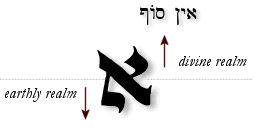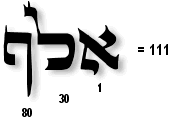|
|
 |
|
|
 |
 |
 |
|
The letter Aleph is the "father" of the Aleph-Bet, whose original pictograph represents an ox, strength, and leader. It's numerical value is one (and also 1,000) and it is a silent letter. Aleph therefore is preeminent in its order and alludes to the ineffable mysteries of the oneness of God. Indeed, the word aluph (derived from the very name of this letter) means "Master" or "Lord."
In the classical Hebrew script (ketav Ashurit) used for writing Torah scrolls, Aleph is constructed with two Yods (one to the upper right and the other to the lower left) that are joined by a diagonal Vav. Ketav Ashurit was the script that Jesus would have read (ketav Ivri was an older script, similar to ancient Phoenician, but was not the script used when Moses received the Torah from the LORD on Sinai. Ketav Ivri is also sometimes called the Temple Script because samples of it are extant dated to the time of Solomon's Temple).
From the Phoenician/Ketav Ivri, the letter Aleph morphed into the Greek letter Alpha  , from which came the Latin A: , from which came the Latin A:
|
 |
|
|
 |
 |
 |
|
- Mysteries of Aleph
In Kabbalistic literature, the upper Yod (meaning an arm) represents the hidden (and infinite) aspect of YHVH called ein sof (×Öµ×× ×¡×Ö¹×£, lit. "without end"), whereas the lower Yod represents the revelation of YHVH to mankind. The Vav, whose meaning is "hook," shows connectedness between the two realms. Vav is also thought to represent humanity, since Adam was created on the sixth day. Vav is diagonal since it is humbled in the face of God's mystery and His revelation. The two Yods also indicate the paradox of experiencing God as both hidden and close, far and near.

- The Gematria of the Parts of Aleph
The basic gematria for Aleph is one, indicating the One and only God who is the Master of the universe. Note, however, that the gematria for the parts of the letter Aleph add up to 26 (Yod+Yod+Vav). This is the same number as the sacred Name YHVH, also indicating a link between the Aleph and God Himself. This is also demonstrated in Exodus 3:14-15, where the LORD reveals His Name to Moses as ehyeh asher ehyeh (×Ö¶×Ö°×Ö¶× ×ֲש×ֶר ×Ö¶×Ö°×Ö¶×), "I AM THAT I AM."

There is a midrash (fable) that asks why Aleph was not selected to be the first letter of the Torah. In the story, all of the letters come before the LORD giving reasons why they should be the first letter - all, that is, except for the letter Aleph. When the LORD asked why, Aleph explained that since he was silent, he had nothing to say. But the LORD honored Aleph's humility and declared him to be the first of all the letters -- and to be honored as the letter of the first word of the Ten Commandments:
×Ö¸× ×Ö´× ×Ö°××Ö¸× ×Ö±××Ö¶××Ö¸
- In the Beginning -- Aleph-Tav
In Or Torah, Rabbi Dov Ber, the Maggid of Mezritch, explained first words of Torah: Bereshit Bara Elohim Et - "In the beginning God created et" (Gen 1:1). Note that et is an untranslatable word used to indicate that "a definite direct object is next" (thus there needs to be an et before the heavens and the earth). But Dov Ber points out that et is spelled - Aleph-Tav, an abbreviation for the Aleph-Bet. Aleph is the first letter of the Hebrew alphabet and Tav the last, so, he reasoned, in the beginning God created the Aleph-Bet. Since God did this before creating the heavens and the earth, the letters are considered to be the primordial "building blocks" of all of creation.
Rabbi Shneur Zalman of Liadi stated that if the letters were to depart even for an instant, all of creation would become absolute nothingness (Zalman, Shneur. 1981. "Igeret Hateshuvah." Likkutie Amarim - Tanya. Brooklyn: Kihot. 289).
- Aleph and the Divine Names
There are a number of divine Names that begin with the letter Aleph, including the following:
 - El - El - Elohim - Elohim - Eloha - Eloha - ehyeh asher ehyeh - ehyeh asher ehyeh - Adonai - Adonai - Adon Olam - Adon Olam - Adir - Adir
- Aleph and the Nature of Man
The Hebrew word for "man" is adam (×××), which is made up of dam (××), "blood," and Aleph (×), which represents the LORD, as indicated above... The LORD turns flesh and blood into nefesh chayah (× Ö¶×¤Ö¶×©× ×Ö·×Ö¼Ö¸×), a "living soul." Yeshua is our Aleph, the One who took on flesh and blood to mediate God's presence to us: with Him we are made real; we come alive; we are born from above (1 John 5:12).
- Aleph is a picture of the God-Man
As One who is composed of both the upper realm of heaven and the lower realm of the earth, connected by the humility of the body, Aleph is a picture of the God-Man unity that is Yeshua HaMashiach, "Who, being in the form of God...took upon himself the form of a servant...as a man..." (Phil 2:6-11).
Moreover, in Revelation 22:13 Jesus refers to Himself as the Aleph and Tav, the First and the Last, and thereby told us directly that the Hebrew Alphabet would provide revelation about Him:

Note that this phrase is a direct reference to Isaiah 41:4, 44:6, and 48:12, where Adonai Himself says that He is the First and the Last -- and explicitly declared that there is no other "god" beside Him.
- Aleph is a picture of Messiah's Intercession
From a Messianic point of view, Aleph represents Yeshua the Mashiach as our Intercessor and Kohen Gadol. The two Yods represent outstretched arms or hands reaching both to mankind and to God. The diagonal Vav represents the sacrifice of Yeshua on our behalf. And since Yeshua is the Aleph and the Tav, the letter represents His divinity, His humility in silence as He opened not His mouth when He was unjustly accused, and so on.
- Aleph is a picture of Oneness in Unity
Aleph also is a picture of three-in-one, or hashilush hakadosh. Just as there are three parts to Aleph, but Aleph is One (echad), so there are three Persons to the Godhead, yet God is absolutely One. The gematria of the word Aleph (×Ö¸×ֶף) is 111 (Aleph=1, Lamed=30, and Pey=80).

- Aleph is Eschatological
Yeshua is called the Aleph and the Tav, and the letter Aleph itself has overtones of the acharit hayamim, or "end of days" spoken of in prophecy. The idea that there are 6,000 years of the Olam Hazeh (the present age before the arrival of the Messiah to set up His kingdom) comes from the fact that there are 6 alephs in the first verse of the Tanakh, and each  represents 1,000. represents 1,000.

- Aleph and Names of God
The first Name of God revealed in the Tanakh is  (elohim), which starts with the letter Aleph. Elohim is also the third word in the Scriptures. Other Names that begin with Aleph include El, Eloha, Elah, Adonai, Av, Avinu, Avir, Abba, etc. (elohim), which starts with the letter Aleph. Elohim is also the third word in the Scriptures. Other Names that begin with Aleph include El, Eloha, Elah, Adonai, Av, Avinu, Avir, Abba, etc.

- Aleph and Metaphors of God
In three places in Scripture the LORD is metaphorically identified with something else. In each case, the metaphor begins with an Aleph:
- Fire
 - Hebrews 12:29, Deuteronomy 4:24 - Hebrews 12:29, Deuteronomy 4:24
- Light
 - 1 John 1:5; Isaiah 10:17; - 1 John 1:5; Isaiah 10:17;
- Love
 - 1 John 4:16 - 1 John 4:16
- Textual Oddities
An undersized Aleph appears in Leviticus 1:1 (Vayikra):

The sages reasoned that Moses' humility (anavah) was such that he waited for the LORD to call him into the ohel mo'ed (Tent of Meeting), despite the fact that God had previously granted him full access to His Presence. The Book of Leviticus begins with vayikra ("and he called") -- spelled with an undersized Aleph -- as a scribal token of Moses' humility.
According to the sages, Moses wanted the word vayikra to be written without the Aleph, as "vayikar" ("and He happened upon," the same word used to describe how the LORD "happened upon" Balaam in Numbers 23:4). In his humility, Moses did not want to use a word that implied that the LORD regularly called to him. However, God overruled him and insisted that the Aleph be included, but allowed Moses to use an undersized version, as a token of his modesty before others.
- Aleph Pictograph
The pictograph for Aleph is the ox or bull, representing strength:

Note that even though the pictograph may represent the basis for ketav Ivri, it may have pagan overtones (e.g., the "bull" god) derived from ancient Canaanite culture.
|
 |
 |
|
Additional Resources:
For further study about the mysteries of the Hebrew alphabet, you may wish to consult the following resources. Note, however, that most of these sources are non-Christian and rely on Kabbalistic interpretations not endorsed by hebrew4christians.com:
- The Secret of Hebrew Words by Benjamin Blech (Aronson, 1991)
- The Hebrew Alphabet, a Mystical Journey by Edward Hoffman (Chonicle, 1998)
- The Book of Letters by Lawrence Kushner (Jewish Lights, 1990)
- In His Own Words by L. Grant Luton (Beth Tikkun, 1999)
- The Wisdom in the Hebrew Alphabet by Michael Monk (Artscroll, 1986)
- Hebrew Word Pictures by Frank Seekings (Living Word Pictures, 1994)
- The Inner Meaning of the Hebrew Letters by Robert M. Haralick (Aronson, 1995)
- The Inner Dimension website (www.inner.org)
- Safrus: STA"M sofer scribal arts (www.safrus.com)
- Mordecai Pinchas - Sofer Scribe (in the UK)
- Eliezar Adam, Sofer Scribe (www.soferstam.com; Chicago)
- Torah Scribe - Jewish Scribal Arts (torahscribe.com)
- The Jerusalem Scribe (www.jerusalemscribe.com; Jerusalem)
- Avraham Borshevsky - Israeli calligraphy artist (goldenscribe.com)
- STA'M - Rabbi Yerachmiel Askotzky's web site (stam.net)
- STA"M - Sofer.net services (sofer.net)
- Hebrew Typography Prints
|
|















